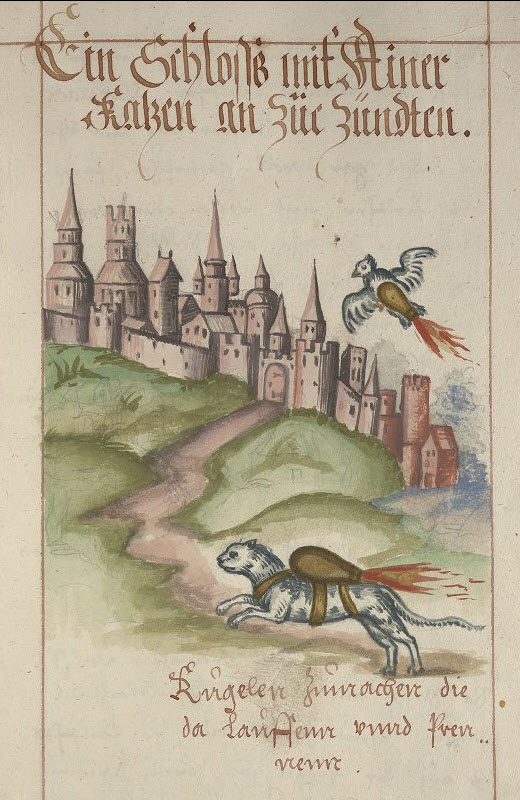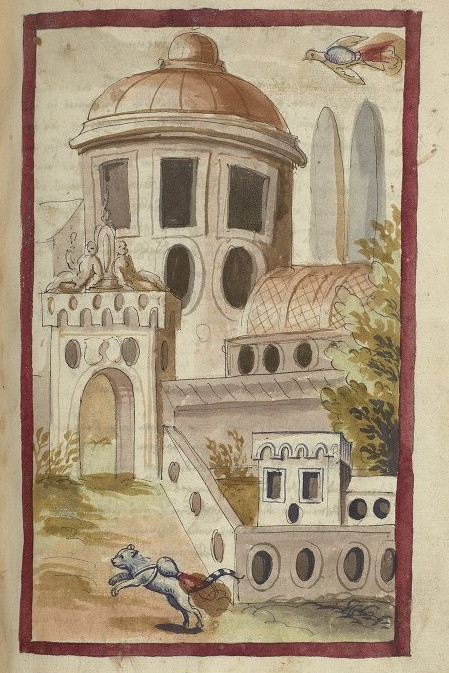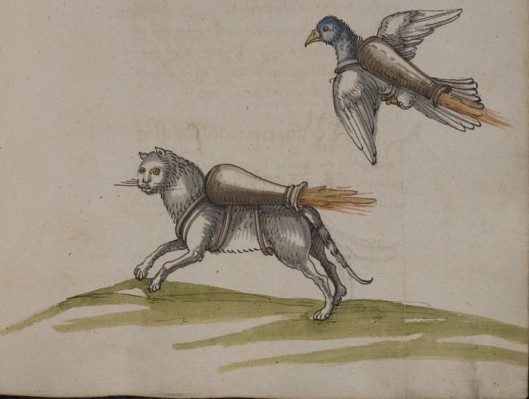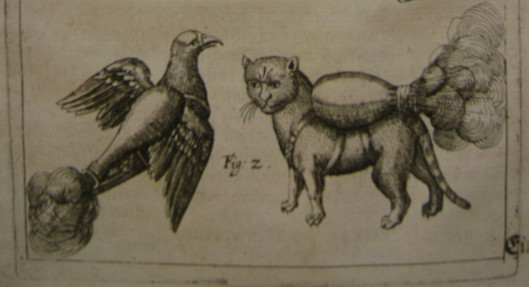I was puzzled when a friend asked me a few weeks ago if I’d seen the “rocket cat” illustrated in a Penn manuscript which had been featured on the book blog BibliOdyssey in November. The image, from what was described as a 1584 “Feuer Buech” manuscript, appeared to show a cat and a bird propelled by rockets towards a castle.

I enthusiastically retweeted the image and began trying to figure out just what was going on in the manuscript [1]. Since then, the “rocket cat” has gone somewhat viral, appearing in the Atlantic, BoingBoing, and elsewhere. Given the illustration’s new-found fame I thought it would be worthwhile to provide a bit of context.
The illustration above comes from UPenn Ms. Codex 109 which came to the library as part of the Edgar Fahs Smith history of chemistry collection. This manuscript is one of several at Penn dealing with the early history of gunpowder, artillery, and explosives. Based on the title I assumed it was one of the many manuscript copies of the famous c.1420 Feuerwerkbuch which provides instructions to artillery masters on how to construct weapons, aim guns, and manufacture various explosives [2]. So where does the explosive cat fit in? I looked through both the printed German text of the Feuerwerkbuch and the English translation in vain – “explosive fire balls” and “fire arrows” are covered in the text but no fire cats. Along the way I also discovered that another of Penn’s manuscripts had an almost identical illustration:

In this case, a c.1590 “Book of instruction for a cannon master.” Clearly these fiery animals were more than just the fancy of one manuscript illustrator. Further, the text accompanying the illustration in both Codex 109 and LJS 442 did not match anything I could trace in editions of the Feuerwerkbuch. Fortunately, in the torrent of tweets about the rocket cat, one came in citing yet another example of the illustration, this time from a manuscript at the Universitätsbibliothek Heidelberg.

Heidelberg has cataloged their manuscript as the “Buch von den probierten Künsten” of Franz Helm. Though drawing on the Feuerwerkbuch, this text dates from a century later (c. 1530) and includes large new sections on siege warfare and different types of explosive weapons. In fact, the Penn collection includes an identified copy of Helm’s treatise, though unillustrated (LJS 254). Thanks to a recent critical edition of the work I was able to confirm that the text of both LJS 442 and Codex 109 were indeed from the Buch von den probierten Künsten [3].
Franz Helm of Cologne was an artillery master in the service of various German princes and likely served in campaigns against Turkish forces during the mid-16th century. His treatise circulated widely in manuscript but was not published until 1625. Remarkably, that print edition of his work (a copy of which is here at Penn) also includes an image of the cat and bird:

So what does Helm actually say about these explosive animals? Are there rockets involved at all? In the text accompanying the images is a section entitled “To set fire to a castle or city which you can’t get at otherwise” [4]. This section details how to use doves and cats loaded with flammable devices to set fire to enemy positions. On cats the text paints a grisly picture of attaching lit sacks of incendiaries onto the animals to have them return to their homes and set fire to them. In my awkward translation:
“Create a small sack like a fire-arrow … if you would like to get at a town or castle, seek to obtain a cat from that place. And bind the sack to the back of the cat, ignite it, let it glow well and thereafter let the cat go, so it runs to the nearest castle or town, and out of fear it thinks to hide itself where it ends up in barn hay or straw it will be ignited.” [5]
There’s no way to know if Helm himself ever employed this method of pyrotechnic warfare but strangely enough the idea of using cats and birds in just this way appears in historical texts from many disparate regions of the world. In a magisterial article on the subject, the Finnish scholar Pentti Aalto cites examples of incendiary-bearing cats and birds from a 3rd c. BCE Sanskrit text, the Russian Primary Chronicle, early Scandinavian sources, and an early modern history of Genghis Khan [6].
Though not actually depicting ‘rockets’ of any kind, these images help demonstrate the enormous demand for manuals on gunnery and explosives in the early modern period as well as the robust world of 16th c. manuscript copying and the persistence of illustrations and manuscript forms into print.
[UPDATE: Alexis Madrigal does a great job summarizing this piece over at the Atlantic! Thanks!]
[UPDATE – March 2014: See additional coverage at Atlas Obscura, the Associated Press and now a wonderful essay from Ben Breen at the Appendix.]
———
[1] For a storified account of these tweets see http://storify.com/MitchFraas/cat-with-jetpack
[2] For a facsimile of the first printed edition of the Feuerwerkbuch (Augsburg, 1529) along with a transcription in modern German see Hassenstein, Das Feuerwerkbuch von 1420, (Munich, 1941). For an English translation of the manuscript text of the Feuerwerkbuch with notes see Gerald W. Kramer and Klaus Leibnitz, “The Firework Book: Gunpowder in Medieval Germany,” The Journal of the Arms & Armour Society 17.1 (March 2001), p. 1-88.
[3] Rainer Lang, Franz Helm und sein “Buch von den probierten Künsten (Wiesbaden, 2001).
[4] In the early modern German text: “Ein Schloß, oder stadt anzünden der du sonst nicht zu kommen magst.”
[5] Many thanks to Brigitte Burris for her help with the text – all errors are mine of course! The Heidelberg manuscript (the most legible) reads: “Mach ein klein secklein wie zu einem fewer pfeyl…tracht ob du mogest Bekhomen im schloss oder statt, ein katzen so darein gehörig, unnd bind das secklein der katzen auff den Rucke, zunde es an lass wol gluen, unnd darnach die katzen Lauffen, So tracht sie dennegsten, dem schloss oder statt zw, und vor forcht gedenckt sie sich zuuerfriechenn, wo sie in scheweren hew oder stroe findt, wurtt es von ir angezundet.” The printed text from the 1625 edition (p.49) is pictured below:
[6] Pentii Aalto, “Kautilya on Siegecraft,” Annales Academiae Scientiarum Fennicae (Series B) 223 (1983), pp. 11-21. The extract from the Russian Primary Chronicle describing the actions of Olga of Kiev (c.945 CE) is particularly striking:
“Olga requested three pigeons and three sparrows from each household. Upon their receipt, her men attached rags dipped in sulphur to the feet of each bird. When the birds returned to their nests, they lit the city on fire and the Derevlians perished in their homes.Olga’s vengeance was now complete.” The Russian Primary chronicle : Laurentian text, (Mediaeval Academy of America,1953), p.81.



29 responses to “A Rocket Cat? Early Modern Explosives Treatises at Penn”
[…] Mitch Fraas’s cutting-edge work on cat bombs may change the face of animal explosive studies forever. […]
It’s Samson all over again. Except, you know, with cats and birds and stuff.
[…] Rocket cats. Actually, rocket-propelled cats and birds in late period manuscripts. How was this a good idea? “I’ll attach a bag of fire to this cat, and it will run into a barn full of straw, thus exploding my enemies!” That’s a Michael-Bay-bad idea. These people have totes never tried to get a cat to do anything. […]
I learned about this from the book Greek Fire, Poison Arrows, and Scorpion Bombs by Adrienne Meyer. Interesting stuff!
So is that where SNL got the idea? http://www.nbc.com/saturday-night-live/video/action-cats/n10236/
[…] Fraas, recently wrote about a 1584 manuscript of a “rocket cat” in Penn’s collection that “has gone somewhat viral” on Unique at Penn, a Penn Libraries blog. Below is an image of the”rocket cat,” which Fraas explains was a possible device used […]
Reblogged this on What exit are we supposed to take? and commented:
Not actually relevant to GIS, but amusing nonetheless!
Interesting, a similar concept was prototyped by the US Military to use against Japan, attaching bombs to bats:
http://en.wikipedia.org/wiki/Bat_bomb
Funny how ideas can keep cropping up!
Thought you’d be interested in our “rocket” cat and bird at the Folger Shakespeare Library: http://luna.folger.edu/luna/servlet/s/t876v2. We clearly need to get to work on improving our catalog record! Thank you!
Thanks Heather – that’s the most elegant one yet!
Reblogged this on Pen, Book, Sword. and commented:
I don’t endorse the militarization of cats but I note that said cats don’t seem to upset with the circumstances. Perhaps this records a brief and terrifying moment of military ascendancy amongst European felines in the late 16th century, now largely lost to history.
We discovered a 1536-1538 version of this manuscript in our collection as well. The drawing is not quite as elegant, though, but the text is similar.
We made a post about it on our Facebook-page, and naturally we also pointed to this blog, where we got the information first.
See: http://www.facebook.com/Museum.Plantin.Moretus.Prentenkabinet#!/photo.php?fbid=548570595164176
[…] https://uniqueatpenn.wordpress.com/2013/02/05/a-rocket-cat-early-modern-explosives-treatises-at-penn/ […]
Just discovered this blog and so far this is one of my favorite posts. Really well written and so interesting! (Terribly inhumane, of course.)
Possibly the most influential psychologist of the 20th Century had a very similar idea, codenamed ‘Project Pigeon’.
http://www.military-history.org/articles/pigeon-guided-missiles.htm
Many thanks to all those who have commented or contributed. Special thanks to Stephen Haw who pointed me to an 11th c. Chinese manual with fire birds and oxen. Also H. Stiles who cites the 11th c. Saga of Harald Hardrade and the use of fire birds in Sicily.
I’m surprised nobody has yet mentioned the rocket-powered rabbit on a skateboard on folio 37r of Giovanni da Fontana’s (1420) “Bellicorum Instrumentorum Liber”. There’s a lo-res scan of it at the bottom of this web-page I put up a few years ago: http://www.ciphermysteries.com/2008/12/06/review-of-le-macchine-cifrate-di-giovanni-fontana
I would have thought that is more likely than anything else so far noted here to be the direct antecedent of the rocket cat meme. 🙂
Thank you so much for that reference Nick. I can’t say I’d seen the juxtaposition of fire bird and fire rabbit before! For those who want to check out a high-res image of the page Nick mentions see http://daten.digitale-sammlungen.de/~db/0001/bsb00013084/image_78
Back from an hour of reading the preview on this engaging military history of the Mongol’s and associated tribes.
http://books.google.com/books?id=ePgHOJs0YU0C&pg=PA1&lpg=PA1&dq=onan+river&source=bl&ots=ApOz8-o-J7&sig=5rZ4KX5gL7DqK2rwu8AnPepFwpc&hl=en&sa=X&ei=VBsuU_2JEJfeoASdr4HoCA&ved=0CFwQ6AEwBQ#v=onepage&q=cats&f=false
Here’s some measure of a source for Genghis Khan’s use of the strategy.
[…] Fraas ha tradotto dall’originale in tedesco: […]
[…] Fraas ha tradotto dall’originale in tedesco: […]
[…] Reading: Mitch Fraas, “A Rocket Cat? Early Modern Explosives Treatises at Penn” Unique at Penn Blog, Jack Couffer, Bat Bombs: World War II’s Other Secret Weapon (University of Texas Press, […]
[…] Inspired by the centenary of the start of World War I, Penn’s archivists and rare book catalogers have combed the Kislak Center special collections for a wide variety of materials documenting war and conflict through the ages. Their favorite finds, which will be on display for this special event, include war propaganda printed on toilet paper, engravings of the Trojan War sold by subscription to fund the 1660 printing of Homer’s Iliad, a spectacular manuscript roll depicting major figures in England’s Wars of the Roses, indulgences sold to raise money for papal armies, 16th-century woodcuts of bizarre inventions for siege-craft and underwater warfare, escape maps and blood chits, soldiers’ songs performed by Marian Anderson, hand-colored illustrations of war elephants, letters to and from soldiers in World Wars I and II, the diary of an American Civil War draft dodger and … Penn’s famous Rocket Cats! […]
[…] relating to historical wars. Among these were medieval manuscripts illustrating the use of rocket-propelled cats as weapons, and World War I-era propagandistic toilet paper picturing the Kaiser! Librarians and […]
[…] meer voorbeelden van vliegende katten vond ik 16e-eeuwse illustraties van katten die als een soort molotov-cocktail werden gebruikt. Hm. — […]
[…] For more details, check out: https://uniqueatpenn.wordpress.com/2013/02/05/a-rocket-cat-early-modern-explosives-treatises-at-penn… and http://www.theguardian.com/books/2014/mar/06/fur-flies-rocket-cats-warfare-manual […]
[…] relating to historical wars. Among these were medieval manuscripts illustrating the use of rocket-propelled cats as weapons, and World War I-era propagandistic toilet paper picturing the Kaiser! Librarians and […]
[…] this 1584 “rocket cat” (and similar “rocket bird”), which I saw discussed at a UPenn blog back in […]
Very similar images are found in a 15th century Hebrew/Yiddish version of Kyeser’s Bellifortis!!